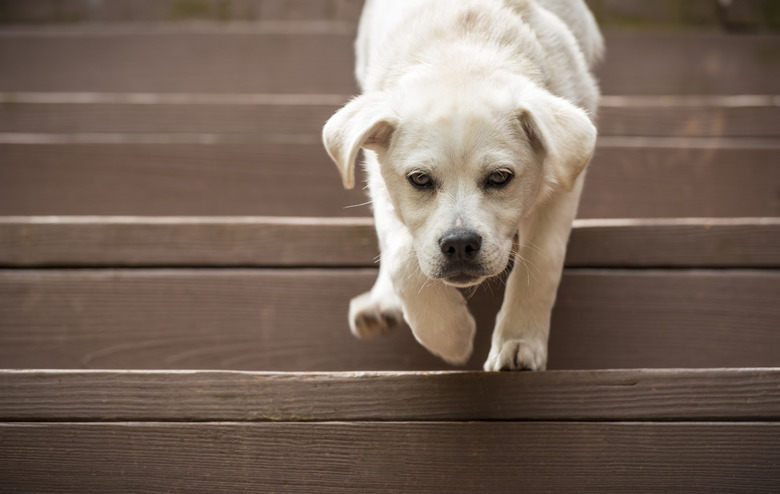Symptoms Of A Dog Who Fell Down The Stairs
Maybe your pup is hesitant to come down the steps or perhaps you heard a suspicious noise when you were in the other room. The thought of your dog taking a nasty tumble down the stairs or watching when your dog fell from a height is frightening. There are a host of potential complications from a bad fall, including sprained muscles, broken bones, and internal injuries.
Stiffness and pain in dogs
Stiffness and pain in dogs
If your dog is hobbling around, walking with a limp, or not moving quite right, they may have taken a bumpy ride down the steps. A limp in the front legs or hind legs suggests pain, weakness, or something wrong in the affected leg.
There are many potential causes of a limp, including growth spurts and arthritis. But trauma, such as a fall, can lead to a variety of potential injuries. Sprains; a torn ligament, muscle, or tendon; a dislocated joint; or nerve damage are all possible from a stumble on the stairs, presenting as a limp or trouble moving around. You may hear them yelping, whining, or crying when they move as well.
Canine internal injuries from falling down the stairs
Canine internal injuries from falling down the stairs
A nasty spill after a dog fell from a height, whether on the steps or coming off a jump, can lead to internal injuries, which can be tough to spot. If you take a fall, you might notice a bruise on your skin as the tiny blood vessels beneath the surface burst from impact.
However, it's difficult to see bruising on your dog since they're likely covered in fur. You can look for signs of internal damage by paying close attention to your dog's behavior. If they're breathing shallowly, they may have lung damage or a broken rib. Coughing up blood can indicate injury to the lungs, abdomen, or gastrointestinal organs.
Signs of shock in dogs
Signs of shock in dogs
Shock often accompanies traumatic injuries, and your dog may show symptoms such as:
- A rapid heart rate
- Bright red lips, gums, and tongue
- Panting
All of these are common in the early stages of shock. In late-stage shock, breathing is much slower and body temperature drops; lips, gums, and tongue are pale; and the pulse is very weak.
Head trauma and brain injuries in dogs
Head trauma and brain injuries in dogs
If your dog bumps their head on a fall on the steps, they may suffer a head injury. A laceration or bleeding is the obvious sign of a head injury, but skull fractures and brain injuries aren't so easy to see. If they have suffered a contusion or bruising, they won't lose consciousness, but they will appear disoriented and wobbly.
If the dog loses consciousness, they have a concussion. It may be mild, showing as a brief loss of consciousness, or severe, lasting hours or days. The dog may experience seizures either immediately after the fall or as long as a couple of days or weeks after the injury as scars form where brain tissue died. In severe brain injuries, the brain swells and bleeds, affecting consciousness, or blood clots may form, showing lowered consciousness, one dilated pupil, and potential weakness or paralysis in the limbs.
Should I take my dog to the veterinarian after falling down the stairs?
Should I take my dog to the veterinarian after falling down the stairs?
If your dog is showing any symptoms of suffering from a fall, it's important they get checked out by a veterinarian to ensure they haven't experienced a serious injury you can't see.
It's possible your dog lost their footing in their exuberance to run down the stairs to get a start on the day. However, if your dog is an old hand at taking the steps, keep a close eye on them to see if they are falling more than usual. There are a variety of reasons a dog may begin to fall, including:
- Inner ear infections
- Vestibular disease or syndrome
- Brain tumors
- Strokes
Older dogs may also have more trouble moving around as they age, which can increase the chances of dog falls. You should have the veterinarian examine them if they are falling more than usual. This is an opportunity to diagnose and treat any health issues your dog may have.
The bottom line
The bottom line
When a dog falls down the stairs, they are likely to be quite sore, and it is possible they also suffered more serious injuries. Dog owners should watch for symptoms such as limping, bruising, difficulty breathing, and disorientation. Take your dog to the veterinarian right away to treat any injuries from the fall.


